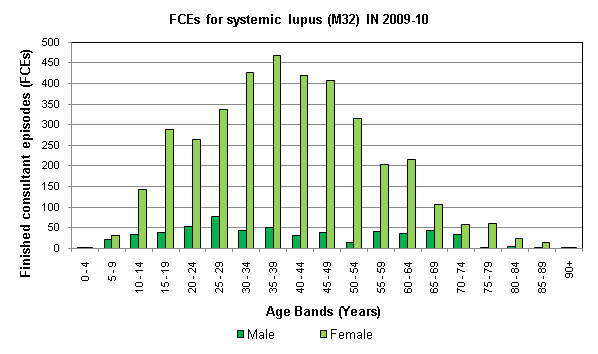IN THIS SITE...

- Lupus UK
- NHS Choices: Lupus
HES on... Systemic lupus
Lupus is a chronic autoimmune disease of which there are two main forms; discoid lupus, which affects only the skin and systemic lupus, which can affect the skin, joints and sometimes internal organs. This article gives an overview of the most prevalent form of lupus, systemic lupus and highlights the related 2009-10 Hospital Episodes Statistics (HES) data.
What is systemic lupus?
According to NHS Choices systemic lupus, simply known as lupus, is caused as a result of the body's antibodies attacking rather than protecting the body's connective tissues, resulting in tissue inflammation.
It is a multi-symptomatic illness and can present itself in variety of ways for each individual with lupus. This can make diagnosis difficult as the symptoms are similar to other conditions such as leukaemia, muscular dystrophy and multiple sclerosis. The most common symptoms experienced by lupus sufferers are:
- joint / muscle aches and pains
- prolonged or extreme fatigue and weakness
- feverishness
- headaches
- depression.
Who does it affect?
According to Lupus UK around 50,000 people in the UK are thought to have lupus, the majority of sufferers 90% are said to be female, a finding which is supported by the HES data for England, 2009-10.
HES data also supports research which suggests that the disease is most prevalent in women during the reproductive years between the ages of 20 and 50.
 |
HES facts and figures
HES data on systemic lupus (primary diagnosis code M32 in ICD-10) shows that in 2009-10:
- 1,234, (31.9%) of hospital admissions for systemic lupus are from waiting lists
- the average time that patients stayed in hospital was 7.5 days
- just under a quarter of patients who are treated in hospital for systemic lupus did not undergo any operative procedure or intervention. Of those that did, the three most common procedures and interventions were:
- continuous infusion of therapeutic substance (X29 in OPCS 4.5) accounting for 1,024 (23.5%) FCEs for systemic lupus
- high cost immunosuppressant drugs (X89 in OPCS 4.5) accounting for 490 (11.3%) FCEs for systemic lupus
- other intravenous injection (X35 in OPCS 4 5) accounting for 332 (7.6%) for systemic lupus.
- it was responsible for 4,350 episodes of admitted patient care, accounting for 10,797 FCE bed days.
More information on this topic is available through the following:
- NHS Choices
- Lupus UK
Footnote:
A finished consultant episode (FCE) is a continuous period of admitted patient care under one consultant within one healthcare provider. FCEs are counted against the year in which they end. Figures do not represent the number of different patients, as a person may have more than one episode of care within the same stay in hospital or in different stays in the same year.

